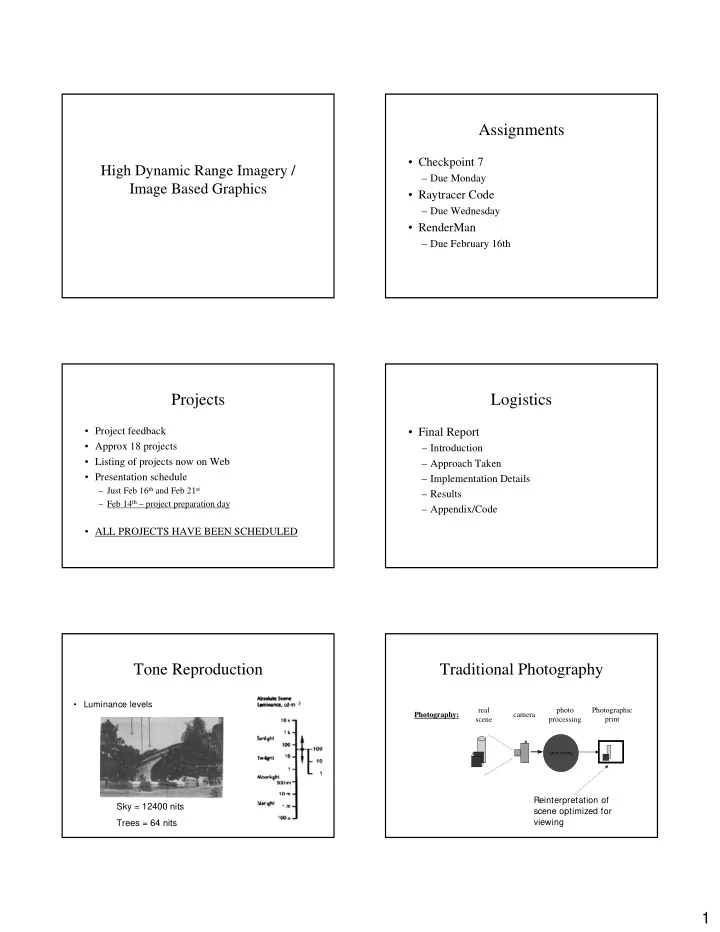

Assignments • Checkpoint 7 High Dynamic Range Imagery / – Due Monday Image Based Graphics • Raytracer Code – Due Wednesday • RenderMan – Due February 16th Projects Logistics • Project feedback • Final Report • Approx 18 projects – Introduction • Listing of projects now on Web – Approach Taken • Presentation schedule – Implementation Details – Just Feb 16 th and Feb 21 st – Results – Feb 14 th – project preparation day – Appendix/Code • ALL PROJECTS HAVE BEEN SCHEDULED Tone Reproduction Traditional Photography • Luminance levels real photo Photographic Photography: camera print scene processing processing Reinterpretation of Sky = 12400 nits scene optimized for viewing Trees = 64 nits 1
Digital Photography Image Synthesis in CG real Processing real photo Photographic Photography: camera Photography: camera scene performed Digital image scene processing print by camera processing processing Computer 3D camera tone synthetic Graphics: models model reproduction image Reinterpretation of scene optimized for Reinterpretation of scene viewing optimized for viewing Scene luminance (24 bit RGB) (24 bit RGB) HDR in Computer Graphics High Dynamic Range (HDR) Imaging • high dynamic range imaging is a set of techniques that allow a far greater dynamic range of exposures than normal digital imaging techniques. • The intention is to accurately represent the wide range of intensity levels found in real scenes, ranging from direct sunlight to the deepest shadows. Wikipedia [Ward 2001] HDR in Computer Graphics HDR Issues • Creation of HDR Images • Storage • Display • Usage [Debevec 2001] 2
Creating HDR images Creating HDR Images • CG Simulation – Ray tracing – Radiosity luminance from scene • Multiple Camera Exposure Lens transmittance π ′ = τ θ + η 4 ( x ) ( L cos I ) t f 2 4 n Aperture / f-stop flare shutter time eff. Creating HDR Images Storing HDR Images • File formats developed for research – Log Encoding (Pixar – TIFF) – RGBE (Radiance) – Log luv (SGI, TIFF) 30 sec 15 sec 8 sec 4 sec 2 sec 1 sec ½ sec ¼ sec – OpenEXR (ILM) – scRGB (Microsoft / HP) • http://www.anyhere.com/gward/hdrenc/ 1/8 sec 1/15 sec 1/30 sec 1/60 sec 1/100 sec 1/250 sec 1/500 1/1000 sec sec [Debevec 1997] High Dynamic Range Images High Dynamic Range Images • OpenEXR • OpenEXR – Can encode – Introduced by Industrial Light and Magic • 9 log units of dynamic range with no loss of precision (ILM) for their computer imagery work. – Also supports – First used in • Compression (lossless & lossy) • Harry Potter and Sorcerer’s Stone • Ability to store “metadata” • Men in Black II • Arbitrary number of image channels • Compatable with Graphics hardware and Realtime Shader • Gangs of New York systems. • Signs – File format and tookit source is open source. – Now used on all ILM film effects projects. – http://www.openexr.org 3
HDR Displays HDR in Computer Graphics • Prototypes in development – 50,000:1 DR – 300:1 – typical device • Note: Tone Reproduction still required for hard copy [Seetzen, et al 2004] output http:/ / www.debevec.org/ RNL/ [Debevec 1998] HDR in Computer Graphics HDR in Computer Graphics HDR in Computer Graphics HDR in Computer Graphics Let’s see this again [Debevec 1998] 4
HDR in Computer Graphics Radiance Maps • Environment mapping using physical lighting values. – Encodes actual light quantities 5
Fiat Lux Blurring the line between geometry and light • Our perception of object geometry is based on the light emitted from them • Light stored as a 4D entity (lumigraph/light field) – Describes flow of light in all directions as precalculated and stored radiance – Ray tracing utilizes these stored values • Independently discovered and published in 1996: Combined image-based modeling, rendering and – Lumigraph – Gortler, et al. lighting to place monoliths and spheres into a – Light Field Rendering – Levoy and Hanrahan photorealistic reconstruction of St. Peter’s Basilica http://www.debevec.org/FiatLux/ break The Lumigraph The lumigraph • a next generation photograph that allows • All light from an object can be represented as if it you to see an image from any angle you can were coming from a cube think of. This is a digital equivalent to a • Each point on the cube hologram. has a number of rays coming from it 6
The lumigraph The lumigraph • Each wall of the cube is actually two parallel planes • Rays are parameterized by where they intersect these planes • Any point in the 4D Lumigraph is identified by it’s coordinates (s,t,u,v) Computer Graphics and The lumigraph Computer Vision processing Computer graphics processing Computer vision Hanrahan, Levoy 1996 Image Based Modeling Image Based Modeling 7
Image Based Modeling Image Based Modeling Image Based Modeling Image Based Modeling • Introduced THREE new techniques! • Photogrammetric modeling using model-based stereo algorithm – User represents scene as a collection of 3D primitives, e.g.,blocks. – Computer solves for sizes and positions of blocks according to user- supplied edge correspondence. • Rendered using view dependent texture mapping – Issues include view dependent lighting, shadows, specular reflection – May need to warp photo details to fit geometry That’s all folks • Next week: – Student Presentations – Recall: No lecture on Monday! • One last bit of business – Course evaluations. 8
Recommend
More recommend